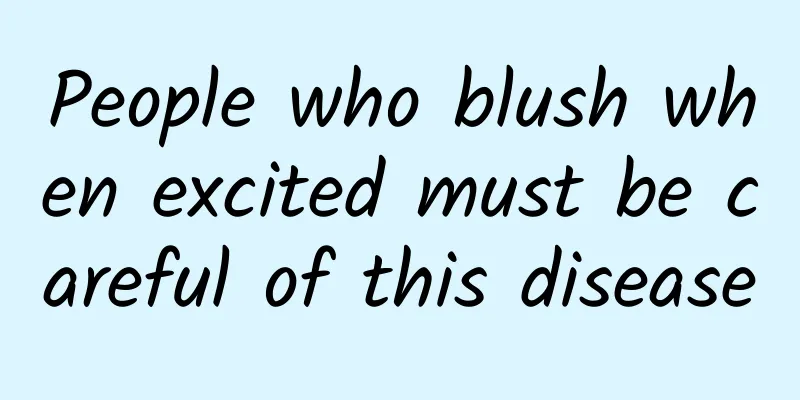People who blush when excited must be careful of this disease

|
The term "red fever" has become very popular on social media recently. It is used to describe a person's emotional state, such as extreme enthusiasm, excitement or high spirits. When a person is excited, a blush will appear on his face, and it may even be as red as an apple. Copyright images in the gallery. Reprinting and using them may lead to copyright disputes. "Red temperature" can be used to describe a blushing face caused by a strong emotional reaction, but why do people blush easily when they get excited in real life? Blushing may be a social statement Blushing is not just a physiological reaction of the body, it is also closely related to our emotions and self-awareness. In social situations, when we feel nervous, shy or aware that we are being noticed by others, blushing tends to become more obvious, especially in people with thinner skin and more capillaries. This response involves a region of the brain called the dorsal hypothalamus, where glutamate neurons become active during emotional stress. They help our bodies generate heat and regulate the constriction of blood vessels to maintain body temperature by sending signals to the globus pallidus nucleus. When these glutamate neurons are activated, they not only help our bodies generate heat, but they also cause blood vessels to dilate, increasing blood flow to the skin, especially the cheeks, causing our faces to turn red. This process is like our body telling those around us that we are feeling uncomfortable or embarrassed. Another theory is that blushing is a defense mechanism, a public statement that we recognize that we may have violated a social norm and want to avoid angering the other person: "I'm sorry, I violated a social norm. Don't be mad at me." Blushing may also be a warning sign of disease Blushing may be related to an individual's concern about negative social evaluation, reflecting a person's heightened sensitivity to social evaluation, which may lead to discomfort and anxiety in social situations. Over time, this worry and associated physiological responses (such as blushing) may increase an individual's risk of developing symptoms of social anxiety disorder . Copyright images in the gallery. Reprinting and using them may lead to copyright disputes. In layman's terms, some people blush easily in social situations. This may be because they are very worried about what others think of them, such as worrying that they will say or do something wrong and be negatively evaluated by others. We call this state of worrying about how others see you "high sensitivity to social evaluation." When a person is always concerned about what others think of them, they may feel uncomfortable or nervous in social activities. If this worry and blushing happens often and lasts for a long time, it may turn into a more serious problem, social anxiety disorder. Social anxiety disorder is a mental health problem in which people worry excessively about being judged or embarrassed in social situations, and this worry affects their daily life and social activities. So, blushing may be an early sign of social anxiety disorder, indicating that the person may need help to deal with these anxious feelings. The study found that blushing may be an early, observable risk marker for social anxiety disorder, and that children's early blushing response (at 4.5 years old) can predict their social anxiety disorder symptoms later (at 7.5 years old). This finding helps researchers and parents note that paying attention to and helping children learn skills to cope with social situations early may be beneficial to their mental health. At the same time, blushing itself is also one of the manifestations of social anxiety disorder. The relationship between blushing and social anxiety is complex. For some people, blushing may be a symptom of social anxiety, especially when they are worried about being evaluated or judged by others. This worry may cause them to feel more uneasy in social situations, thereby increasing the experience of social anxiety. Blushing itself may become a focus, causing individuals to worry that others will notice their blushing, which further exacerbates anxiety. Their social anxiety is mainly due to the fear of blushing, rather than being afraid of many different social situations like other people with social anxiety. Although they may appear confident, they are actually very worried about blushing in front of others, and this fear has a great impact on their social ability and daily life. They are afraid of blushing because they think it will make them embarrassed in front of others. They also exhibit unique autonomic modulation, with higher heart rate and heart rate variability under psychological stress conditions, which are typically associated with higher sympathetic and parasympathetic activity; and lower sensitivity to blood pressure. Copyright images in the gallery. Reprinting and using them may lead to copyright disputes. In general, these people's social anxiety is primarily a fear of blushing, which creates some challenges in their social life. Such patients may need specific treatment to target their fear of blushing and their heightened physiological response. How should we deal with blushing? Although blushing may be a sign of illness, we should not pay too much attention to it, otherwise it will increase the risk of disease. When we blush, we must learn to calm down, keep calm, take slow, deep breaths, and try to stay away from situations that may make you blush. You can also reduce blushing by diverting your attention. By recording the events that make you blush on a daily basis, you can exercise your attention in a safe environment, deliberately divert your attention to specific matters, and reduce the focus on yourself. If blushing has caused obvious anxiety and prevented you from participating in social activities normally, you should seek medical attention and professional help promptly. References [1]Mathis V, Kenny PJ. Neuroscience: Brain Mechanisms of Blushing. Curr Biol. 2018;28(14):R791-R792. [2]Red in the Face: The Science of Blushing. scu.edu. 2016. https://www.scu.edu/illuminate/thought-leaders/phil-kesten/red-in-the-face-the-science-of-blushing.html [3]Nikolić M, Majdandžić M, Colonnesi C, et al. The unique contribution of blushing to the development of social anxiety disorder symptoms: results from a longitudinal study. J Child Psychol Psychiatry. 2020;61(12):1339-1348. [4]Jefferson JW. Social Anxiety Disorder: More Than Just a Little Shyness. Prim Care Companion J Clin Psychiatry. 2001;3(1):4-9. [5]Voncken MJ, Bögels SM. Physiological blushing in social anxiety disorder patients with and without blushing complaints: two subtypes? Biol Psychol. 2009;81(2):86-94. [6]Pelissolo A, Moukheiber A, Lobjoie C, et al. Is there a place for fear of blushing in social anxiety spectrum? Depress Anxiety. 2012;29(1):62-70. [7]Laederach-Hofmann K, Mussgay L, Büchel B, et al. Patients with erythrophobia (fear of blushing) show abnormal autonomic regulation in mental stress conditions. Psychosom Med. 2002;64(2):358-65. [8]Chaker S, Hofmann SG, Hoyer J. Can a one-weekend group therapy reduce fear of blushing? Results of an open trial. Anxiety Stress Coping. 2010;23(3):303-18. Planning and production Author: Jiang Yongyuan, Master of Internal Medicine, Third Military Medical University Review丨Zhang Yu, researcher/PhD, Chinese Center for Disease Control and Prevention, national health science expert Fan Chunlei, Associate Researcher, Institute of Psychology, Chinese Academy of Sciences Planning丨Fu Sijia Editor: Fu Sijia Proofread by Xu Lailinlin The cover image and the images in this article are from the copyright library Reprinting may lead to copyright disputes |
<<: This great achievement in the history of mathematics is attributed to the Arabs?
Recommend
Template for planning fission activities!
1. #Split the wheel lottery game and get a gift b...
Nanny-level Zhihu Marketing Strategy [7000 words full process]
Zhihu marketing is an issue that almost every bra...
China Anesthesia Week丨The Guardian of "Intoxicating" Beauty: Let's Learn About the Mysterious "Anesthesia Clinic"
The last week of March 2025 is the 9th "Chin...
One picture to understand | Fly × 16! See the journey of Shenzhou flying into space
Produced by: People's Daily x Dongdongmiao...
How much does it cost to customize a nutritional supplement mini app in Xinyu?
According to industry insiders, mini programs wil...
For bidding promotion, just read this article!
Today, based on years of experience in bidding pr...
The first flight was a success! Hybrid power, unmanned operation... What are the strengths of the first "hybrid version" of the Long March rocket?
Image source: Xinhua News Agency After much antic...
Can the split posture make Xiaomi TV 3 worthy of the title of "next generation"?
Last week, the term "next generation" c...
What is 404 not found? How to solve 404 not found?
For many novice website builders, when building a...
Deadly and fatal! Is the "beautiful killer" in the ocean also an excellent doctor?
Produced by: Science Popularization China Author:...
The nine-square grid thinking method of APP in the application market!
The boss is going crazy because there is no promo...
iQIYI Verb Wireless Earphones: 25 days of ultra-long standby, lightweight and luxurious wireless sound experience
What is the most important thing for young people...
Install Linux terminal emulation and environment app for Android
Today I recommend a Linux terminal emulation and ...
QQ was permanently banned. How did I get it unblocked after more than 200 days?
I believe many people have had the experience of ...
Comic: Human Code Evolution Illustrated Book
Reviewer: Luo Huiqian, Associate Researcher, Inst...







![UDesign - [Jia Jia Jia] A Beginner's Guide to Color Matching for Commercial Illustrations](/upload/images/67cc0f6393ae0.webp)

